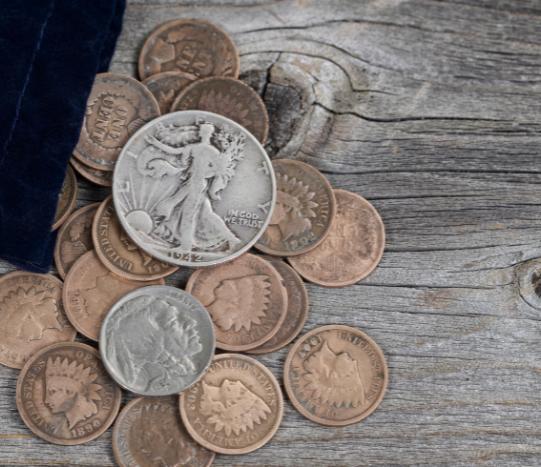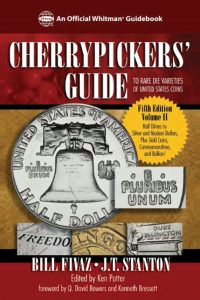
Bill Fivaz is best known as the co-author of the Cherrypickers’ Guide to Rare Die Varieties of United States Coins. He was a governor of the American Numismatic Association (ANA) from 1985 to 1989, and a recipient of the ANA’s highest honor in 1995. Fivaz was twice awarded the ANA Medal of Merit and M. Vernon Sheldon Memorial Award. In 2020, he was filmed in Atlanta for the ANA Legacy Series.
Define “cherry picking.”
Cherry picking is the use of acquired knowledge, after a great deal of time and study, to uncover certain features that would increase the value of a coin being offered at a normal price. It may be a doubled die, a repunched mintmark, a misplaced date or something similar.
What should you keep in mind when trying to find coins that look normal at first glance, but have unusual characteristics that can turn a common coin into a rare and valuable variety?

Learn how to recognize the difference between die doubling and strike doubling. This confounds many collectors and leads them to believe they have a more valuable doubled die rather than the very common strike doubled feature.
The basic difference is that a coin with a doubled die has the secondary images raised and rounded like the 1955 Doubled Die cent, whereas a coin that exhibits strike doubling has that image flat, shelf-like and close to the field. This aberration is sometimes referred to as mechanical, machine, ejection doubling, etc., and occurs when one die is loose and twists at the time of impact with the planchet.
This shears metal off the surface of the highest portions of the die, making it look doubled. In essence, this is damage to the coin and is common in every series. If a coin is a Proof or mint state example, that secondary image with strike doubling will often appear shiny in that area, as it is now raw metal from the shearing effect.
Learn the best places to look on a series to pick up ‘cherrypickable’ features. On Washington quarters, for example, the motto IN GOD WE TRUST is a good starting point. On the Seated Liberty series, check the denticles for remnants of a misplaced number punch from the date.
 On many coins, doubling can be seen on the motto, the date or LIBERTY. Learn these pick-up points for each series and start your search there. A great example of this is the 1916-P Doubled Die Obverse (DDO) Buffalo nickel. This is a collectible and valuable variety. You can cherrypick it on a dateless coin. An important diagnostic of this doubled die is doubling on the three feathers behind the Indian’s neck. Each is doubled to the right, and you should zero in on the longest feather to check for this doubling.
On many coins, doubling can be seen on the motto, the date or LIBERTY. Learn these pick-up points for each series and start your search there. A great example of this is the 1916-P Doubled Die Obverse (DDO) Buffalo nickel. This is a collectible and valuable variety. You can cherrypick it on a dateless coin. An important diagnostic of this doubled die is doubling on the three feathers behind the Indian’s neck. Each is doubled to the right, and you should zero in on the longest feather to check for this doubling.
If you find one, go celebrate at the nicest restaurant, because you just rang the bell. The grading services will slab this coin, and even without a date, you’re probably looking at a four-figure value.
Look for new varieties that have not yet been reported. New, exciting ones are still being found. Testament to this is the recently discovered very dramatic doubled die on the 1919-P Mercury Dime. It shows clearly on the motto IN GOD WE TRUST and very few have surfaced.
Please discuss the ethics of cherry-picking. What if you’re browsing through a dealer’s inventory and find a coin with a $50 asking price that you believe is worth $500? Is it fair game to pay $50 or less to the dealer?
The ethics of cherry-picking can be controversial. Should a cherrypicker tell the owner of the coin that it is a valuable variety and pay accordingly? My take on this is that if the owner of the piece is a non-collector and you are buying “Uncle Fred’s” collection, by all means, you should advise the owner that the variety is worth more than the normal coin and factor that into the final offer. Wish to figure out more information regarding IGT casinos? If so, read the report from fancasinos.in experts. You will discover all pros and cons of IGT slots as well as platforms to play on.
If you are buying from a dealer, my feeling is that if the dealer hasn’t taken the time to research the stock for varieties, and you spent the time and effort to do so, that’s what cherrypicking is all about. Very often, if I know the dealer, I’ll say something before buying the coin, and nine times out of 10 the dealer will still sell it to me at the normal price. Also, when I find a variety that I can’t use while searching a dealer’s stock— whether I know the dealer or not—I always tell the dealer that the variety is worth a bit more money.
What’s the most common hidden rarity that someone can find when cherry-picking? What’s the most valuable coin you know that was cherry-picked?
Aside from the 1916-P DDO Buffalo, about 30 years ago, I cherrypicked a Good 1829 Curled Based 2 Bust dime. Another time, I found a mint state 1976-D Bicentennial DDO quarter. Back in 1955 when you could go to the bank and get all the silver dollars you wanted, I bought a bag of 250 Morgan/Peace dollars and glommed onto about eight uncirculated 1928-P Peace dollars.
How can a collector turn an interest of cherry picking into a project mentality? Are there “sets” of coins such as repunched mintmarks or doubled dies?
My advice to collectors who like to search Proof and Mint sets for varieties, and there are many to be found in these sets, is to check Appendix D in the Cherrypickers’ Guide where they will find a listing of collectible varieties that have been found.
This article about cherry-picking coin strategies previously appeared in COINage magazine. To subscribe click here.












